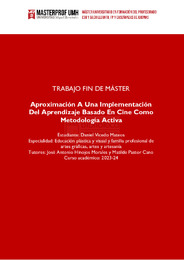Por favor, use este identificador para citar o enlazar este ítem:
https://hdl.handle.net/11000/32749Full metadata record
| DC Field | Value | Language |
|---|---|---|
| dc.contributor.advisor | Hinojos Morales, José Antonio | - |
| dc.contributor.advisor | Pastor Cano, Matilde | - |
| dc.contributor.author | Vicedo Mateos, Daniel | - |
| dc.contributor.other | Departamentos de la UMH::Arte | es_ES |
| dc.date.accessioned | 2024-07-26T10:00:09Z | - |
| dc.date.available | 2024-07-26T10:00:09Z | - |
| dc.date.created | 2024 | - |
| dc.identifier.uri | https://hdl.handle.net/11000/32749 | - |
| dc.description | Especialidad: Educación plástica y visual y familia profesional de artes gráficas, artes y artesanía | es_ES |
| dc.description.abstract | El cine es una herramienta pedagógica que puede aportar mucho al proceso de enseñanza-aprendizaje. Tradicionalmente ha sido empleado como una mera herramienta sin verdadera relevancia en el plan de estudios de las materias de secundaria. Estudios previos del uso del cine en las aulas reconocen su efectividad de cara a una mejora significativa de la motivación y el rendimiento del alumnado en situaciones de aprendizaje que hacen uso de fragmentos de películas y análisis fílmico. Por medio de una revisión bibliográfica de publicaciones sobre el uso del audiovisual en el aula, se busca realizar una aproximación a un método estandarizado que permita sacar el máximo rendimiento a una metodología centrada en el cine. Los hallazgos muestran el potencial en base a las aportaciones científicas de la bibliografía consultada. Y se propone la necesidad de continuar la investigación para poder establecer las pautas concretas que permitan que cualquier asignatura pueda sostener su temario sobre tareas centradas en el análisis fílmico. | es_ES |
| dc.description.abstract | Cinema is a pedagogical tool that can contribute vastly to the teaching-learning process. Traditionally, it has been used as just a tool without any real relevance in the study programme of secondary school subjects. Previous studies on the use of cinema in classrooms acknowledge its effectiveness in significantly improving student motivation and performance in learning situations that make use of film clips and its analysis. Through a bibliographic review of publications on the use of audiovisuals in the classroom, an attempt is made to establish a standardized method that allows maximizing the performance of a methodology centered around cinema. The findings show its potential according to the scientific contributions of the consulted bibliography. It shows the need to persist on the research in order to establish the specific guidelines that would allow any subject to sustain its set of topics on tasks centered on film analysis. | es_ES |
| dc.format | application/pdf | es_ES |
| dc.format.extent | 27 | es_ES |
| dc.language.iso | spa | es_ES |
| dc.publisher | Universidad Miguel Hernández de Elche | es_ES |
| dc.rights | info:eu-repo/semantics/openAccess | es_ES |
| dc.rights | Attribution-NonCommercial-NoDerivatives 4.0 Internacional | * |
| dc.rights.uri | http://creativecommons.org/licenses/by-nc-nd/4.0/ | * |
| dc.subject | Análisis fílmico | es_ES |
| dc.subject | Herramienta pedagógica | es_ES |
| dc.title | Aproximación a una implementación del aprendizaje basado en cine como metodología activa | es_ES |
| dc.type | info:eu-repo/semantics/masterThesis | es_ES |

View/Open:
TFM VICEDO MATEOS, DANIEL FRANCISCO.pdf
1,2 MB
Adobe PDF
Share:
.png)
